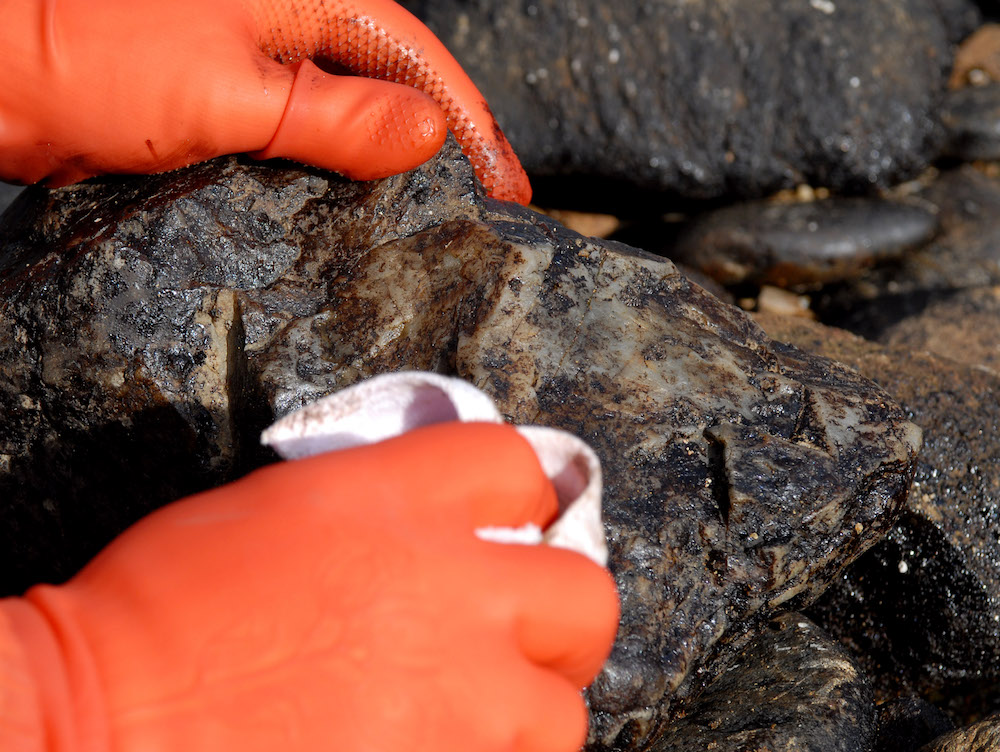
[Image above] An Airman from Kunsan Air Base cleans a rock after crude oil spilled from a crane barge and washed ashore. Magnetic oxides may prove an effective way to clean up oil spills in the future. Credit: U.S. Air Force/Senior Airman Steven R. Doty
A few weeks ago, I attended a local presentation by researchers who investigated factors causing the Deepwater Horizon oil spill (also known as the BP disaster). In April 2010, a blowout occurred on the BP-operated Macondo Prospect drilling rig, and it resulted in what is currently considered the largest marine oil spill in United States history—more than 200 million U.S. gallons (780,000 cubic meters) of crude oil poured into the Gulf of Mexico.
While this specific presentation focused on how the researchers determined which failures led to the drilling rig’s collapse, I have attended other presentations that instead focused on environmental impacts of the spill, such as effects on wildlife and the cleanup workers.
One detail I find most concerning about the Deepwater Horizon oil spill is that the chemical dispersants used to clean up the oil may have actually worsened the environmental impact. The chemical dispersants were supposed to break oil into droplets that natural oil-eating bacteria could more easily consume, but it appears the dispersants instead suppressed the bacteria’s activity.

As much as we may hope that oil spills will not occur if we improve safety measures, accidents will always happen. In the nine years since BP, there have been more than 60 confirmed oil spills, with one already in 2019.
To prepare for these spills, we need better ways to clean up oil, preferably methods that do not rely on toxic dispersants. Instead, some studies have investigated a different way to clean up oil—sorbents.
Sorbents are insoluble materials that are used to recover liquids through either absorption or adsorption, or both. Sorbents used to combat oil spills must be both oleophilic (oil-attracting) and hydrophobic (water-repellent).
However, current sorbents are somewhat limited—because of challenges including poor reusability and cost efficiency, sorbents are used as sole cleanup only in small spills or as a way to remove final traces of oil after other oil-removing methods have been used. Sorbent materials that could be used for large-scale oil cleanups are not yet developed enough to be economically feasible.
To scale up the size of spills that sorbents can tackle, researchers from Friedrich–Alexander University Erlangen–Nürnberg in Germany have proposed scaling down the size of sorbent materials—specifically, they propose using iron oxide nanoparticles that can attract various types of hydrocarbons.
(Hydrocarbons include crude oil, but also petrol, diesel, and light compounds like alkanes and aromates.)
In a study published in February, the FAU researchers describe how superparamagnetic magnetite (Fe3O4) nanoparticles (NPs) combine several key parameters of sorbent materials meant for large-scale use: they are inexpensive and easily available, they have a large surface-to-volume ratio (good for sorption rates), and they can be easily collected and reused.
However, magnetite NPs have a low affinity to hydrocarbons. To increase affinity, the researchers coated magnetite NPs with hexadecylphosphonic acid (PAC16), a material that forms a self-assembled, hydrocarbon-adsorbing monolayer on the NP surface.
A FAU press release describes how “… hydrocarbon molecules surround the very fine [magnetite] particles as if they are being sucked in and reach a volume that can grow to 14 times the size of the core of the particle.”
Due to their magnetic nature, the NPs were easily collected from the water using a magnet. After the researchers removed hydrocarbons from the NPs, they repeated the process and were able to show constant extraction rates over ten consecutive extraction cycles.
The press release states the researchers are currently working with industry partners to scale-up manufacturing of their NPs and ideally transfer the concept to real-world cleanup operations.
Of course, sorbents cannot be used in every oil spill situation—a situation with heavy winds and tides would make it difficult or impossible to collect sorbents. Improving other methods like booms and skimmers, nontoxic dispersants, and biological agents for biodegradation all must occur if we wish to minimize environmental damage following a spill.
The paper, published in Advanced Functional Materials, is “Superoleophilic magnetic iron oxide nanoparticles for effective hydrocarbon removal from water” (DOI: 10.1002/adfm.201805742).
